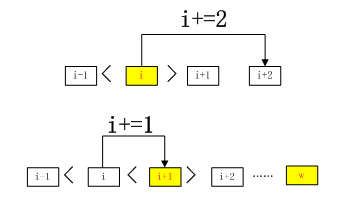转自:https://blog.csdn.net/u014365862/article/details/53376516
非极大值抑制(Non-Maximum-Suppression)
注意看哦,有两个版本的。
理论基础
说实话,讲理论基础实在不是我的强项,但是还是得硬着头皮来讲,希望我的讲解不至于晦涩难懂。
非极大值抑制,简称为NMS算法。是一种获取局部最大值的有效方法。在3领域中,假设一个行向量的长度为w,从左向右,由第一个到第w个和其3领域中的数值进行比对。
如果某个i大于i+1并且小于i-1,则其为一个绝不最大值,同时也就意味着i+1不是一个局部最大值,所以将i移动2个步长,从i+2开始继续向后进行比较判断。如果某个i不满足上述条件,则将i+1,继续对i+1进行比对。当比对到最后一个w时,直接将w设置为局部最大值。算法流程如下图所示。
应用范围
非极大值抑制NMS在目标检测,定位等领域是一种被广泛使用的方法。对于目标具体位置定位过程,不管是使用sw(sliding Window)还是ss(selective search)方法,都会产生好多的候选区域。实际看到的情形就是好多区域的交叉重叠,难以满足实际的应用。如下图所示。

针对该问题有3种传统的解决思路。
第一种,选取好多矩形框的交集,即公共区域作为最后的目标区域。
第二种,选取好多矩形框的并集,即所有矩形框的最小外截矩作为目标区域。当然这里也不是只要相交就直接取并集,需要相交的框满足交集占最小框的面积达到一定比例(也就是阈值)才合并。
第三种,也就是本文的NMS,简单的说,对于有相交的就选取其中置信度最高的一个作为最后结果,对于没相交的就直接保留下来,作为最后结果。
总体来说,3种处理思路都各有千秋,不能一概评论哪种好坏。各种顶会论文也会选择不同的处理方法。
- <span style="font-size:14px;">#include <iostream>
- #include <opencv2/core/core.hpp>
- #include <opencv2/highgui/highgui.hpp>
- #include <opencv2/opencv.hpp>
- // 新版本写在下面文件中:
- #include <opencv2/nonfree/features2d.hpp>
- //#include "opencv2/features2d/features2d.hpp"
- #include<opencv2/legacy/legacy.hpp>
- using namespace std;
- using namespace cv;
- void nms(
- const std::vector<cv::Rect>& srcRects,
- std::vector<cv::Rect>& resRects,
- float thresh
- )
- {
- resRects.clear();
- const size_t size = srcRects.size();
- if (!size)
- {
- return;
- }
- // Sort the bounding boxes by the bottom - right y - coordinate of the bounding box
- std::multimap<int, size_t> idxs;
- for (size_t i = 0; i < size; ++i)
- {
- idxs.insert(std::pair<int, size_t>(srcRects[i].br().y, i));
- }
- // keep looping while some indexes still remain in the indexes list
- while (idxs.size() > 0)
- {
- // grab the last rectangle
- auto lastElem = --std::end(idxs);
- const cv::Rect& rect1 = srcRects[lastElem->second];
- resRects.push_back(rect1);
- idxs.erase(lastElem);
- for (auto pos = std::begin(idxs); pos != std::end(idxs); )
- {
- // grab the current rectangle
- const cv::Rect& rect2 = srcRects[pos->second];
- float intArea = (rect1 & rect2).area();
- float unionArea = rect1.area() + rect2.area() - intArea;
- float overlap = intArea / unionArea;
- // if there is sufficient overlap, suppress the current bounding box
- if (overlap > thresh)
- {
- pos = idxs.erase(pos);
- }
- else
- {
- ++pos;
- }
- }
- }
- }
- /**
- *******************************************************************************
- *
- * main
- *
- *******************************************************************************
- */
- int main(int argc, char* argv[])
- {
- std::vector<cv::Rect> srcRects;
- /*
- // Test 1
- srcRects.push_back(cv::Rect(cv::Point(114, 60), cv::Point(178, 124)));
- srcRects.push_back(cv::Rect(cv::Point(120, 60), cv::Point(184, 124)));
- srcRects.push_back(cv::Rect(cv::Point(114, 66), cv::Point(178, 130)));*/
- /*
- // Test 2
- srcRects.push_back(cv::Rect(cv::Point(12, 84), cv::Point(140, 212)));
- srcRects.push_back(cv::Rect(cv::Point(24, 84), cv::Point(152, 212)));
- srcRects.push_back(cv::Rect(cv::Point(12, 96), cv::Point(140, 224)));
- srcRects.push_back(cv::Rect(cv::Point(36, 84), cv::Point(164, 212)));
- srcRects.push_back(cv::Rect(cv::Point(24, 96), cv::Point(152, 224)));
- srcRects.push_back(cv::Rect(cv::Point(24, 108), cv::Point(152, 236)));*/
- // Test 3
- srcRects.push_back(cv::Rect(cv::Point(12, 30), cv::Point(76, 94)));
- srcRects.push_back(cv::Rect(cv::Point(12, 36), cv::Point(76, 100)));
- srcRects.push_back(cv::Rect(cv::Point(72, 36), cv::Point(200, 164)));
- srcRects.push_back(cv::Rect(cv::Point(84, 48), cv::Point(212, 176)));
- cv::Size size(0, 0);
- for (const auto& r : srcRects)
- {
- size.width = std::max(size.width, r.x + r.width);
- size.height = std::max(size.height, r.y + r.height);
- }
- cv::Mat img = cv::Mat(2 * size.height, 2 * size.width, CV_8UC3, cv::Scalar(0, 0, 0));
- cv::Mat imgCopy = img.clone();
- for (auto r : srcRects)
- {
- cv::rectangle(img, r, cv::Scalar(0, 0, 255), 2);
- }
- cv::namedWindow("before", cv::WINDOW_NORMAL);
- cv::imshow("before", img);
- cv::waitKey(1);
- std::vector<cv::Rect> resRects;
- nms(srcRects, resRects, 0.3f);
- for (auto r : resRects)
- {
- cv::rectangle(imgCopy, r, cv::Scalar(0, 255, 0), 2);
- }
- cv::namedWindow("after", cv::WINDOW_NORMAL);
- cv::imshow("after", imgCopy);
- cv::waitKey(0);
- return 0;
- }</span><span style="font-size:11px;">
- </span>
实验结果:
- <span style="font-size:14px;">#include <iostream>
- #include <opencv2/core/core.hpp>
- #include <opencv2/highgui/highgui.hpp>
- #include <opencv2/opencv.hpp>
- // 新版本写在下面文件中:
- #include <opencv2/nonfree/features2d.hpp>
- //#include "opencv2/features2d/features2d.hpp"
- #include<opencv2/legacy/legacy.hpp>
- using namespace std;
- using namespace cv;
- static void sort(int n, const vector<float> x, vector<int> indices)
- {
- // 排序函数,排序后进行交换的是indices中的数据
- // n:排序总数// x:带排序数// indices:初始为0~n-1数目
- int i, j;
- for (i = 0; i < n; i++)
- for (j = i + 1; j < n; j++)
- {
- if (x[indices[j]] > x[indices[i]])
- {
- //float x_tmp = x[i];
- int index_tmp = indices[i];
- //x[i] = x[j];
- indices[i] = indices[j];
- //x[j] = x_tmp;
- indices[j] = index_tmp;
- }
- }
- }
- int nonMaximumSuppression(int numBoxes, const vector<CvPoint> points,const vector<CvPoint> oppositePoints,
- const vector<float> score, float overlapThreshold,int& numBoxesOut, vector<CvPoint>& pointsOut,
- vector<CvPoint>& oppositePointsOut, vector<float> scoreOut)
- {
- // 实现检测出的矩形窗口的非极大值抑制nms
- // numBoxes:窗口数目// points:窗口左上角坐标点// oppositePoints:窗口右下角坐标点// score:窗口得分
- // overlapThreshold:重叠阈值控制// numBoxesOut:输出窗口数目// pointsOut:输出窗口左上角坐标点
- // oppositePoints:输出窗口右下角坐标点// scoreOut:输出窗口得分
- int i, j, index;
- vector<float> box_area(numBoxes); // 定义窗口面积变量并分配空间
- vector<int> indices(numBoxes); // 定义窗口索引并分配空间
- vector<int> is_suppressed(numBoxes); // 定义是否抑制表标志并分配空间
- // 初始化indices、is_supperssed、box_area信息
- for (i = 0; i < numBoxes; i++)
- {
- indices[i] = i;
- is_suppressed[i] = 0;
- box_area[i] = (float)( (oppositePoints[i].x - points[i].x + 1) *(oppositePoints[i].y - points[i].y + 1));
- }
- // 对输入窗口按照分数比值进行排序,排序后的编号放在indices中
- sort(numBoxes, score, indices);
- for (i = 0; i < numBoxes; i++) // 循环所有窗口
- {
- if (!is_suppressed[indices[i]]) // 判断窗口是否被抑制
- {
- for (j = i + 1; j < numBoxes; j++) // 循环当前窗口之后的窗口
- {
- if (!is_suppressed[indices[j]]) // 判断窗口是否被抑制
- {
- int x1max = max(points[indices[i]].x, points[indices[j]].x); // 求两个窗口左上角x坐标最大值
- int x2min = min(oppositePoints[indices[i]].x, oppositePoints[indices[j]].x); // 求两个窗口右下角x坐标最小值
- int y1max = max(points[indices[i]].y, points[indices[j]].y); // 求两个窗口左上角y坐标最大值
- int y2min = min(oppositePoints[indices[i]].y, oppositePoints[indices[j]].y); // 求两个窗口右下角y坐标最小值
- int overlapWidth = x2min - x1max + 1; // 计算两矩形重叠的宽度
- int overlapHeight = y2min - y1max + 1; // 计算两矩形重叠的高度
- if (overlapWidth > 0 && overlapHeight > 0)
- {
- float overlapPart = (overlapWidth * overlapHeight) / box_area[indices[j]]; // 计算重叠的比率
- if (overlapPart > overlapThreshold) // 判断重叠比率是否超过重叠阈值
- {
- is_suppressed[indices[j]] = 1; // 将窗口j标记为抑制
- }
- }
- }
- }
- }
- }
- numBoxesOut = 0; // 初始化输出窗口数目0
- for (i = 0; i < numBoxes; i++)
- {
- if (!is_suppressed[i]) numBoxesOut++; // 统计输出窗口数目
- }
- index = 0;
- for (i = 0; i < numBoxes; i++) // 遍历所有输入窗口
- {
- if (!is_suppressed[indices[i]]) // 将未发生抑制的窗口信息保存到输出信息中
- {
- pointsOut.push_back(Point(points[indices[i]].x,points[indices[i]].y));
- oppositePointsOut.push_back(Point(oppositePoints[indices[i]].x,oppositePoints[indices[i]].y));
- scoreOut.push_back(score[indices[i]]);
- index++;
- }
- }
- return true;
- }
- int main()
- {
- Mat image=Mat::zeros(600,600,CV_8UC3);
- int numBoxes=4;
- vector<CvPoint> points(numBoxes);
- vector<CvPoint> oppositePoints(numBoxes);
- vector<float> score(numBoxes);
- points[0]=Point(200,200);oppositePoints[0]=Point(400,400);score[0]=0.99;
- points[1]=Point(220,220);oppositePoints[1]=Point(420,420);score[1]=0.9;
- points[2]=Point(100,100);oppositePoints[2]=Point(150,150);score[2]=0.82;
- points[3]=Point(200,240);oppositePoints[3]=Point(400,440);score[3]=0.5;
- float overlapThreshold=0.8;
- int numBoxesOut;
- vector<CvPoint> pointsOut;
- vector<CvPoint> oppositePointsOut;
- vector<float> scoreOut;
- nonMaximumSuppression( numBoxes,points,oppositePoints,score,overlapThreshold,numBoxesOut,pointsOut,oppositePointsOut,scoreOut);
- for (int i=0;i<numBoxes;i++)
- {
- rectangle(image,points[i],oppositePoints[i],Scalar(0,255,255),6);
- char text[20];
- sprintf(text,"%f",score[i]);
- putText(image,text,points[i],CV_FONT_HERSHEY_COMPLEX, 1,Scalar(0,255,255));
- }
- for (int i=0;i<numBoxesOut;i++)
- {
- rectangle(image,pointsOut[i],oppositePointsOut[i],Scalar(0,0,255),2);
- }
- imshow("result",image);
- waitKey();
- return 0;
- }
- </span>





























 2万+
2万+

 被折叠的 条评论
为什么被折叠?
被折叠的 条评论
为什么被折叠?








